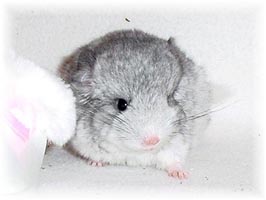
Breeding Chinchillas for Profit
Thinking about breeding chinchillas because it is profitable? Think again. Most people have no idea all the needs and the cost in the beginning and as time goes by.
First, you need to learn as much as you can about chinchillas, first-hand, if possible. Adopt two or three and raise them for a year or so. You need to know how they act and re-act to you and the surroundings. Enjoy playing with them ... once you get 20 or more, you will have little time to play and spend the time with each one as you would like to do.
Second, an exotic pet vet that knows about chinchillas and is easily accessible. You need to find your vet before you get a chin and know that he/she is familiar with working with chinchillas. Regular vets do not treat chinchillas and not all exotic vets know very much about them. They are delicate creatures that, when sick, need care immediately! Vet bills are not cheap, be prepared a head of time, most expect payment at the time you take your chin in.
Third, you have to have a facility or room(s) suitable for the chins to live in comfortably. One that will have a controlled environment (central heat/air and an extra window
unit air-conditioner incase your central unit fails). Extravagant? No, this happened to me. Just as we were getting ready to walk out the door to leave town, our central-air quit. We had to rush out and buy a window unit and install it in order to keep the chins (120 of them) cool or we would have come home to heat-stroked dead chins. We now keep the window unit on at all times during the summer months and set it on 70, so that if something happens to the central-air while we are gone, the window unit will kick in to protect them. We also have a generator that will kick in should we not be home. We can take care of ourselves, but, the chins count on us to take care of them.
Lighting should be natural, you can use the 'natural-light lightbulbs', they are more expensive and do not last as long as regular bulbs, but are better for the chinchillas. Ionizers can be used in the area, they are in to help with the quality of air for both you and your chins.. Fresh air from the outside is also needed, even if you just open the windows for 30 minutes each day/evening.
A a radio or t.v. left on while you are gone is good for them and calms them and keeps them from being bored. Chins will often start chewing fur when they are bored or stressed.
Various sizes of cages used for different reasons. Holding cages (12" x 12" x 21" and/or 18" x 12" x 21")
to place the kits in when they are weaned from their mom or are waiting to be adopted. These are small enough to let them
feel secure, yet large enough to allow a little room for some play. Individual breeding cages 12" x 18" x 21" or
larger (Some set-up for individual breeding and some set-up in breeding runs) Breeding runs can be used to help
economically. When using breeding runs, you will have one male 'servicing 3 or more females ... otherwise, he will be
sitting around twitting his thumbs all but about 10 days out of a year. We have one male to 3 females in a total of 4
cages (so he works about 1 month out of the year). hehehe Some individual breeding cages (not all chins like runs
and will choose only one partner) and play cages with exercise wheels 22" x 18" x 24". Two isolation cages ..
. others can be added, if needed. One 24" x 30" x 48" or 18" x 24" x 30" cage with chins as a display cage as to what size and set-up is best for home use.
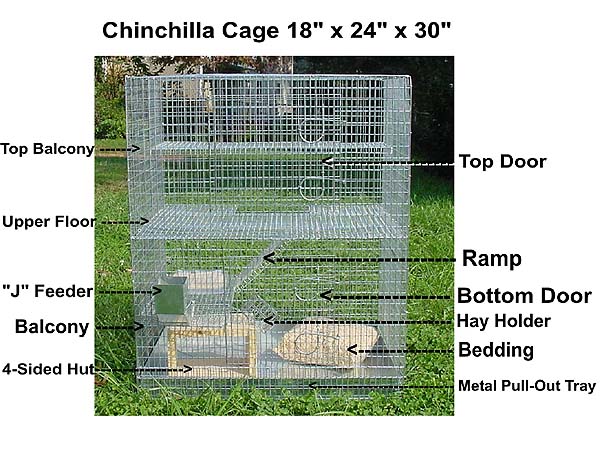
Have you checked on the cost of cages lately? Costs to buy ready-made cages (for a run of 4) ranges from $350
to $600 (for quality cages)... IF you buy wire in bulk ($500 minimum order) and make them yourself + have trays custom made for them, the cost is approximately $150 to $250 per run of 4, not counting the hours of labor and the supplies needed to put them together.
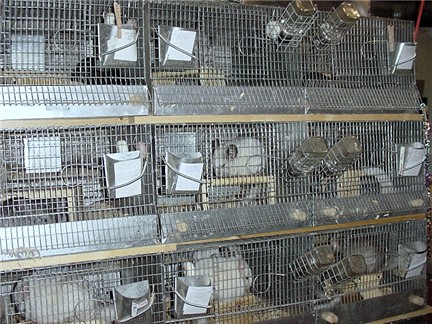
Most cages need to be on rolling or easy-sliding bases for easy cleaning behind and under them. Mine
are 21" above floor level with storage space in each base. Protection (such as a painter's plastic drop sheet
to protect he walls and carpet. A camera and photo props, chin dust bath containers, extra feeding bowls and supplies can be kept in storage area below the cages. An area and equipment for photos to be made of each chin/chin family. You want to be able to show people what they look like before they decide if they want to adopt it or not. This also helps keep down the flow of 'strangers' going in and out of your home.
Food and Nutrition. This is another necessity for chins. I use Mazuri Chinchilla Diet Pellets (believed to
be one of the top 3 containing the proper content and percent of nutritional needs for a chinchilla ... the other two
are Oxbow and National Chinchilla Diet Pellets). We use approximately 75 pounds of chinchilla pellets per week at
a cost of $30 per week. Hay is needed daily. Usually I use loose hay daily, but occasionally hay nuggets.
Chin dust bath dust has to be purchased for them ... we buy in bulk of 50 pound bags.
Chin dust bath containers cost us $20 each, custom made. Each chin and/or chin family has to have it's
own dust bath container. Each chin/chin family has to have at least 2 water bottles (one in use and one to
replace it with) ... each bottle cost approximately $8. Each chin/chin family needs a feeding bowl/bowls or
dispensers. Each has it's own hay holder. Each has it's own lava stone ... our cost $1.20 each
(we buy by the gross) ... some last a month ... some last 2 months ... a necessity for good teeth. If a chin becomes
ill or urinates on the lava stone, it is disposed of. A dishwasher to serialize bottles and dishes plus
cost of doing so, is efficient and best. Cleaning supplies and vat big enough to hold a tray
for soaking and sterilizing them when cleaning. Steam cleaner for cages, unless you want to break
your back scrubbing. Rolling or easy-glide stands for holding supplies and bedding bends. Stands for each
section of chinchilla cages. Exercise wheels (at a cost of about $60 each). A safe, chin-proofed play area,
Huts for each chin. Pine wood chew sticks and toys for all. 4" PVC pipe for kits
to hide/play/sleep in safely. Pine chip bedding for cages. Air-tight food storage containers.
Books ($35 to $45 each) on chinchillas, breeding, health, research and history and chinchillas in general.
Breeding record books for each year, Jamie has a great one in the on line Chinchilla Club Store.
Computer and web site ... used for chinchilla information in general and on some chinchillas specifically.
Camera and Photo Program used for keeping records and sending out photos of chins. Printer
and supplies used for booklets, printing pictures and making business cards.
Other things that are needed occasionally are: a calcium substitute, vitamin C, Acidophilus, Critical Care, Petromalt
for fur balls, Nutri-Cal, and Pydialite when needed/instructed by the vet.. And weakened apple or
cranberry juice on occasions, as needed. New born formula for kits when large litters (3 or 4 kits) are
born or if mom's milk does not come in adequately or fast enough.
To keep them happy, treats (one per day per chin) consist of rose hips, dried papaya, spoon size shredded
wheat, raisins, or cranrasins One treat per chin per day, not one of each.
If you plan on going on vacation, you will need a chin-setter to keep an eye on your little ones and tend to their needs while you are gone. I have found it best to hire someone to help me one day a week cleaning cages and learning how to take care of them properly while I am here, so that they can do so when I am gone. This also gives you a chance to see if you feel they are learning enough and have the gentle touch it takes for chinchillas.
Think the things above come to a tidy sum? Here comes your main cost (next to the vet bills, that is):
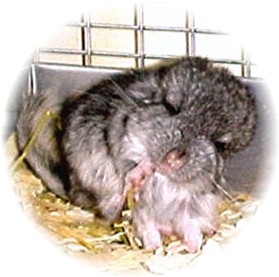
Quality breeding stock cost more than kits can be sold for as pets or to other hobby or small breeders ... example: a quality breeding standard gray female (the lowest on the price list) is $200 to $300+ each ... standard gray kits for pets sell for $100 each ... as the number of pet chins increase and the number of breeders (even if the quality is not as good) the pet price will fall, yet, the price for quality breeders will not fall. Highest priced mutants (other than Sapphire) is the quality homo ebony breeders cost $800 to $1,500+ each ... pet ebonies sell for $200 to $400.
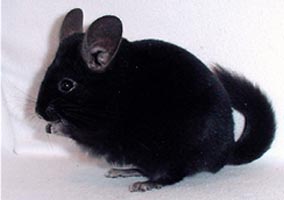
To breed chinchillas for profit, you need 300 to 3,000 chins. Here we are talking about chin buildings, not chin rooms.
To become a small breeder and/or a hobby breeder, you will need all the things listed above, to become a big breeder or chinchilla rancher, you will need it all, but in larger quantities. :)
|